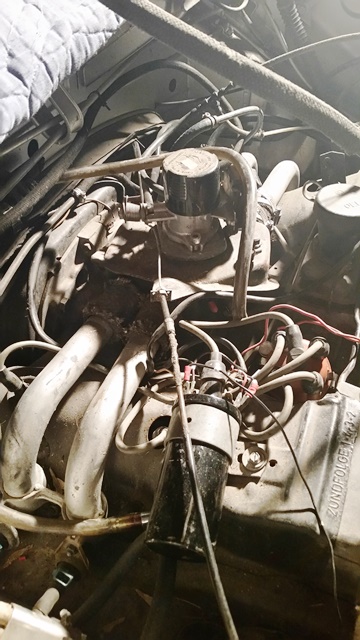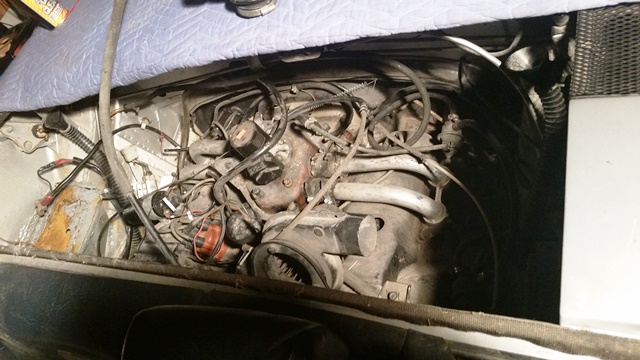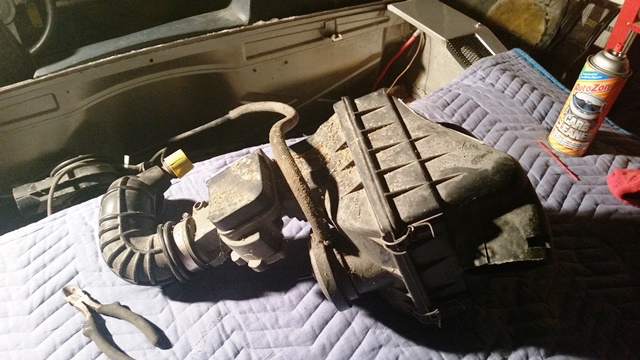mikesjunk
Dec 20 2015, 05:39 PM
Ok so I'm working on a 1971 914-4 which from another thread it appears to have a 75-76 2.0 912E L-Jet FI system on it from the PO.
I have plumbed new fuel lines through out the car, cleaned fuel tank and it has fresh gas.
I went through the dual relay and redid it all which I did find one wire on the wrong terminal from the diagram I had.
The previous symptom was that it would start and then die when the key was released. So I threw a battery in it and yep that's what it does. It will fire and run momentarily then die.
First issue is that I don't hear the fuel pump run. It's currently wired from the original harness with some PO adds ons like a fuse. It is not wired to the dual relay but back into the harness that runs to the relay box. I put a meter on it while testing and didn't ever see any voltage. So to make sure this wasn't the issue I hot wired it to run off the battery while I tested that. But that didn't fix the main issue.
Next item is that the ignition switch looks like it's from the movies and has been hot wires. Of course they did it through and around the knee pad so I'm digging into that now. I unwired it so I could remove the knee pad.
From the ignition switch area there looks like 4 wires. red, red/black stripe, a black and a gray. The gray one wasn't hooked to anything.
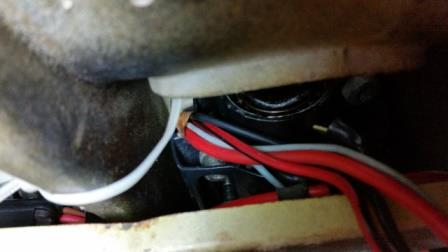
From the harness there were 5 wires. The Black/Yellow and Blue/Yellow weren't hooked to anything.
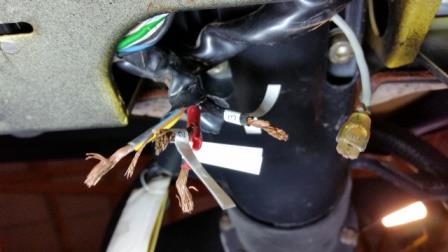
I'll start researching the wiring diagrams but anyone want to post a response to short cut this would be appreciated.
Also the key/cylinder feels pretty bad so anyone recommend someone who can go through it? I saw a guy on ebay listing this but looking for recommendations as it will need something eventually.
rick 918-S
Dec 20 2015, 06:47 PM
If it cranks and fires with the key that's good. The wiring may be a mess but at least some of it is connected correctly. Check power to the coil with the key on. If that is good. Check to see the fuel lines are connected correctly. The pressure regulator should be last in the fuel flow direction. (after the injectors) This will cause the exact symptom you described.
steuspeed
Dec 20 2015, 07:00 PM
The key cylinders are fairly simple. It may just need a clean and lube. Be careful taking it out as it has little wafers of different sizes that match up to your key. You have to get them back in the same way they came out. There are a bunch of threads about key cylinders.
Ignition switch is a known failure point. Changing it out is a good idea while you are in there. Save the old one as a spare.
mikesjunk
Dec 20 2015, 07:41 PM
I did check voltage at the coil and it stays at 12+ from key on, during cranking and key release.
I'm pretty sure fuel lines are correct. I did have to add a fuel filter as there wasn't one. I put it in front of the pump since it was 3/8 fittings and the pump inlet was 3/8 but 5/16 outlet. So fuel lines run from tank, to filter to pump to passenger injectors to nozzle on intake to driver injectors to some vacuum valve to pressure regulator back to tank. And let me say old gas really sticks up the shop.

914Sixer
Dec 20 2015, 07:42 PM
70-71 ignition column was sourced from the VW Type3. Lock is unique to the 914.
r_towle
Dec 20 2015, 08:42 PM
Ok,
You mention dual relay, that is Ljet fuel injection.
A 75 2.0 liter would be Djet fuel injection.
If it's Ljet you have a guy here names Timothy who is really good at the wiring, so change the title of yr thread to suck him in by mentioning
Ljet in the title....he won't be able to resist.. ( hi Tim)
Simple test.
Turn key to run
Remove rubber intake boot to that AFM ( air fuel meter)
Open the flapper door on the AFM, the fuel pump should come on and you should be able to hear it.
If not, you need to troubleshoot your Ljet system.
Rich
mikesjunk
Dec 20 2015, 09:14 PM
http://www.914world.com/bbs2/index.php?act...=2&t=271077Thanks r_towle I'll add L-Jet to title. Also need to update the description as it was estimated to be a 912E 2.0l FI from the thread above. There are some pics in that thread.
I'll try the AFM trick. But does that come from the 71 fuel pump operation or from the dual relay? As currently the fuel pump is not connected to the dual relay.
I know in one of the many bookmarks I've added recently there was a whole battery of tests to do for the FI. Which I'll have to find and print out for more troubleshooting.
mikesjunk
Dec 23 2015, 02:15 PM
Additional info.
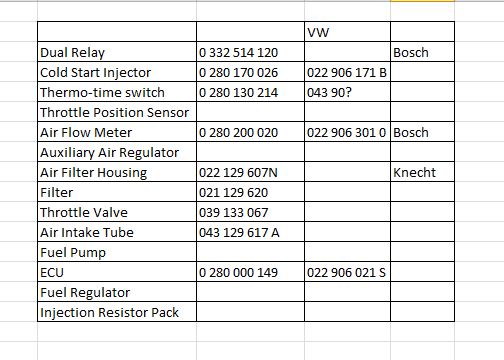
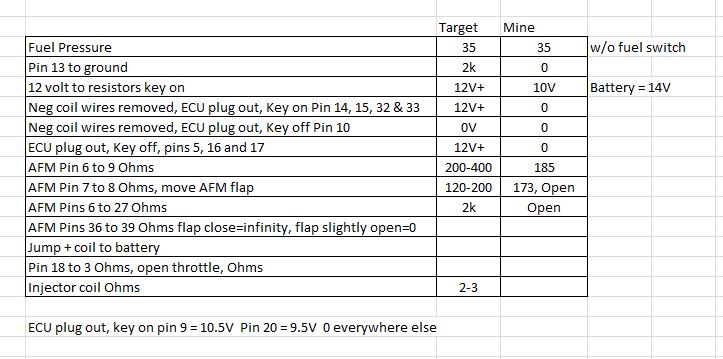
Ok first item the fuel pressure. I have what I would call the regulator as it has an adjustment screw. I also have something with a vacuum line. So I also hooked up my vacuum pump and pulled a vacuum on the first item to see if it was blocking the line. No luck. And turning the screw on the regulator didn't do anything for the pressure.
As for the rest, I'm off to message Tim to peek at this thread as it look likes there's lots wrong.
ndfrigi
Dec 23 2015, 02:52 PM
the 2nd time I did fix something underneath the fuel tank, my engine start and stop a few seconds until I noticed a sound that looks to be a fuel is not flowing. So raised up the fuel tank and notice I have a fuel hose that is crinkled, well drop the tank and check from the hole below the front trunk where the under cover pan is, to check if fuel hose is not crinkled. And that fixed my problem.
Well that is for my 75 1.8 Ljet and it can be another issue on yours or other cars.
mikesjunk
Dec 23 2015, 06:21 PM
I already found the kinked line under the tank.

So I now have correct fuel pressure but I took this out as it's not opening. So what is it?
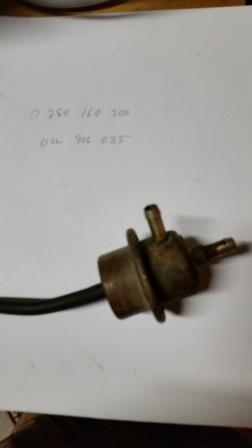
I updated my chart above as I must of not read Tim's other post well for checking the AFM. I thought the pin #'s were for the harness not at the AFM. So updated chart numbers at AFM.
timothy_nd28
Dec 23 2015, 11:28 PM
Nice chart, but I see some red flags. I'm curious if you're probing the right pins on the ECU connector?
Try this: put everything back together, including the fuel regulator. Now, find a way to jump pin 88d at the dual relay (should be a big black wire with red stripe) to the positive battery post. You should hear the fuel pump turn on. See if the car starts and stays on longer than 3 seconds. This will help isolate the problem and point us in a direction on how to further diagnose.
914fahrer
Dec 24 2015, 06:35 AM
QUOTE(mikesjunk @ Dec 24 2015, 01:21 AM)

I already found the kinked line under the tank.

So I now have correct fuel pressure but I took this out as it's not opening. So what is it?

I updated my chart above as I must of not read Tim's other post well for checking the AFM. I thought the pin #'s were for the harness not at the AFM. So updated chart numbers at AFM.
This is the correct fuel regulatur for the L-jetronic.Only the D-jetronic regulatur has a adjustment screw.
Gruss Ralf
mikesjunk
Dec 24 2015, 08:53 AM
Thanks for stopping by Tim. The chart is basically what I pulled from some of your replies to a similar topic. Thought it would be best to knock out the things you were probably going to ask. I may need to layout the whole harness wiring as it doesn't seem to line up with some of the pins you've pointed to. For instance there is no terminals in hole 8.
Also, to be clear my fuel pump is not currently wired to the dual relay (probably wired like a 71 D-jet) so that pin is open on the relay. Not sure if the jumping of terminals will get it to turn on since it's not part of the relay. Mine is wired into a factory looking harness that runs in front of the engine over to the relay/ECU area. I did jump it out to a battery previously to see if the car would run, but it would still die upon release of the key.
As for the fuel regulator if what is pictured is correct then should I also have one with a screw? I have both in the system....remember thread title is Frankenstein so not sure what I have from the PO and various people that were under the hood. I also tried applying a vacuum to this and did not get any flow through it. With it out of the system and the screw regulator one still in I have 35psi and flow back to the tank. If I put this back it I will have 75psi and applying a vacuum won't open it.
r_towle
Dec 24 2015, 11:40 AM
Tim is the man
timothy_nd28
Dec 24 2015, 11:40 AM
Very interesting!
I am not good with part numbers, but a quick search on google revealed that the ECU is from a 77 VW Transporter?
We need to get a bearing on whats what with the wiring harness. Pin one at the ECU connector should be the injector signal from the negative post of the ignition coil. So, I would start there and check the resistance between pin one at the ECU connector to the negative post on the ignition coil, you should read 0 ohms.
If you don't read 0 ohms, move your meter probe to another pin at the ECU connector till you find 0 ohms. Since the car starts briefly, we can't be that far off.
Try to post additional pictures of the engine bay compartment.
timothy_nd28
Dec 24 2015, 11:54 AM
Rich, you made my wife LOL last night after she read your post, it was much needed. We were re-grouting the kitchen floor yesterday with awful results
mikesjunk
Dec 24 2015, 12:23 PM
LOL, it seems to be a matter of perspective. Guess when the harness is on the bench I know which way to count but not when it's in the car. Figured that out when I had it laying on the bench again. So here's some more updates.
As for the fuel system here's it is back to how I received it but with new hoses. So you can see I have two regulators?
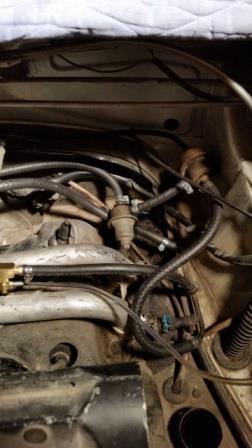
I've updated the parts list with some more numbers.
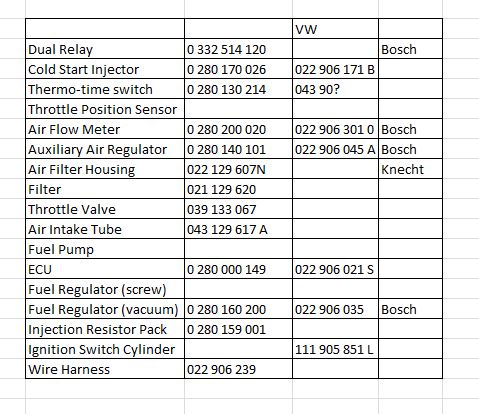
Here is my harness pin out. Note that mine does not have 2,3, 18 for the throttle but only 12 goes to the throttle switch. The rest seem to line up...when you count right.

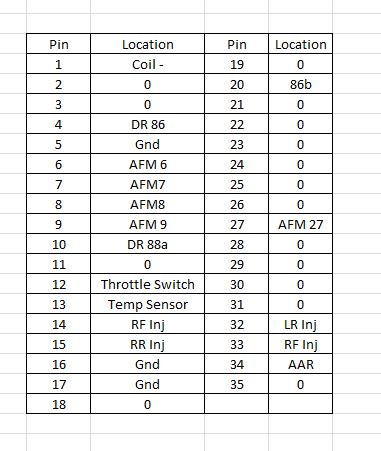
And now the results are a bit better with the right pins but still seems to be some things not right. After I got it all back together I tried again and still starts right up and then dies.
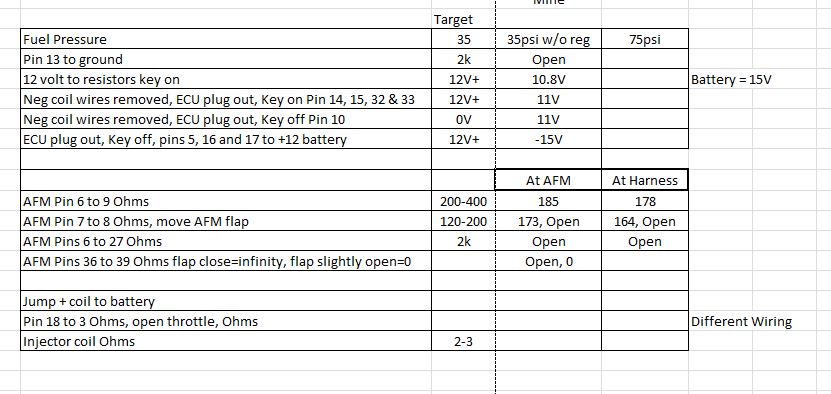
mikesjunk
Dec 24 2015, 12:26 PM
timothy_nd28
Dec 24 2015, 12:56 PM
Click to view attachment I'll turn a blind eye to your fuel delivery, being that you are getting 35 psi when you start the car, and even when it stalls, right? We can come back to that later
The biggest problem right now is pin 13 to engine ground. This is your cylinder head sensor, and is needed for your car to run. See if you can locate the cylinder head sensor which is located by the passenger side intake manifold, toward the rear of the car. Post a picture of that if you can
mikesjunk
Dec 24 2015, 02:16 PM
For Pin 13 yes it was to ground and I also did it from the pig tail on the passenger side to ground bypassing the harness and both were open. The wire disappears through a gromment. So I'll pop out the grommet and see what's there.
For the resistors I check the voltage at the plug at the resistors, unplugged from the resistors.
Yes at harness means at the ECU end of the harness. And pin 12 does ring out at the throttle switch. No pins 2,3, or 18 in harness.
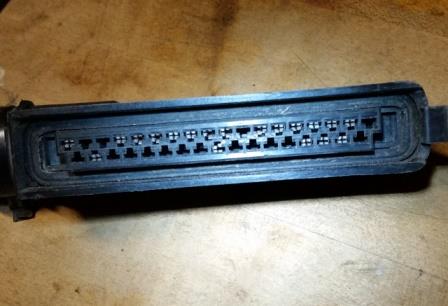
For the coil one of the first items I did was have the meter on it and it maintains 12v from key on, start to key release...so I didn't jump to it as it didn't seem necessary.
timothy_nd28
Dec 24 2015, 02:34 PM
Good, applying power straight to the coil with the engine not running is a good way to ruin the points or pointless module inside the distributor.
Go ahead and investigate the cylinder head temperature sensor, meanwhile I'll see if I can find a pin out for your ECU
timothy_nd28
Dec 24 2015, 03:27 PM
This is a true Frankenstein!
Pin 12 should not go to the throttle switch. Pin 12 is reserved for the altitude compensation device. This holds true atleast up till 1978 California Vanagons, your ECU is from a 77 Vanagon.
Now, there seems to be 4 different variations of ECU's for the 77 Vanagon, and I'm not exactly clear what the real difference between them are. From what I gather, some had manual transmission ECU's while others had automatic transmission ECU's. I believe some where California ECU's. Your year ECU seems to be the threshold of when they started to not use the throttle valve (WOT) switch. You may have a mismatched wiring harness for the ECU you have. Again, not 100% sure of this.
Either way, the throttle switch is not causing your issue. We need to see some resistance on pin 13 at the ECU connector. Also, do you have a 6 or 7 pin air flow meter
mikesjunk
Dec 24 2015, 04:40 PM
7 pin AFM
Here's a photo of the temp sender. This doesn't look like it's going to be fun to change. Anyone know what size that is as I'm guessing I'll need to slit a socket to get this out.
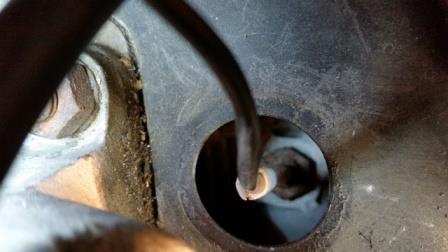
There are only two wires on the throttle switch in the connector. Next trip out I'll see which pins on the throttle switch they are on and where the other one goes.
I need a computer in the shop!

But I guess I'm doing the pre-Christmas dinner workout.
mikesjunk
Dec 24 2015, 05:31 PM
Throttle Switch
Ok so here's what the pigtail to the throttle switch looks like.
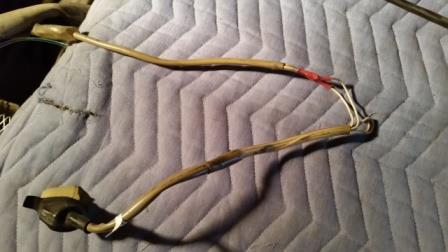
This has obviously been subject to POs. So the two wires that show looping back, they go no where. I ended up splitting this open since I couldn't get them to ring out.
So here it is on the switch. The two wires highlighted in yellow both ring out back to #12 in the ECU connector. The other two go no where.
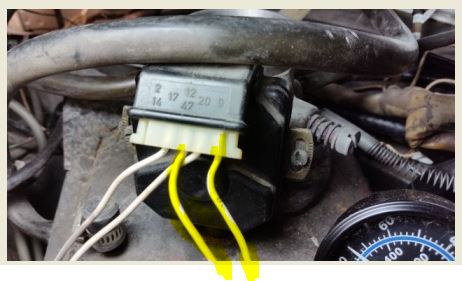
JeffBowlsby
Dec 24 2015, 07:09 PM
I should go back a reread this whole thread...bizzarro...what else can be said? Looks like you have a 912E engine or at least some of its injection system, with a 5-pole D-Jet TPS connector morphed into it for who knows what purpose. Here is a photo of a 912E engine/fuel injection if it of any assistance. I have more photos if you need them.
I also have downloadable D-Jet and L-Jet Fuel Injection manuals (including 912E) here:
http://bowlsby.net/914/Classic/TechNotebook.htm914 Ignition and FI wiring harness diagrams may be useful in wringing this harness out:
http://bowlsby.net/914/WiringHarnesses/
mikesjunk
Dec 24 2015, 07:19 PM
Thanks Jeff, I've already been on your site a time or two.
Yes this is quite the challenge. The worst is that at one time it ran. Then it's been in the garage for a number of years having been worked on by several different people. I have no idea what parts it came with and what ones were put on it attempting to make it run. So who knows if it ran in its current configuration, but my sister thought I needed a challenge.
I have a Polaris ATV next to it in many pieces that I'm not sure which one has been the most challenging.

mikesjunk
Dec 31 2015, 04:26 PM
Hope everyone has been having a good holiday's. Bumping this back up with some updates.
Bought a cheap socket at Harbor Freight and cut a hole in it so I could remove the cylinder head temp sensor. Got it out and still it has 0 ohms and no ring on continuity. So I ordered a new cylinder head temp sensor. It came on Wednesday and guess what it also has 0 Ohms and does not ring on continuity. So this one is still a mystery. It was a Bosch sensor. Went ahead and installed it and I still have the same issue. Starts and then dies upon key release.
So I guess it could be my meter as its a cheap backup so on my shopping list is to replace my good meter that finally died after a couple of decades. But I'm not betting on this being the reason why the sensor doesn't have any Ohms.
mikesjunk
Jan 2 2016, 01:11 PM
Note to self: Don't use a cheap meter for trouble shooting
So got a new meter and redid the results. I'm quite surprised at the difference in readings between the two meters. Well one's in the trash now. Same conditions, starts but dies when key is released.
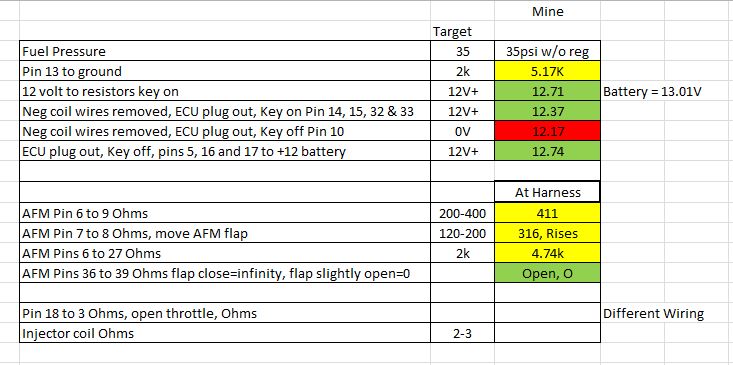
Dave_Darling
Jan 2 2016, 07:33 PM
L-jet should use the dual relay to run the fuel pump. D-jet uses one of the round relays on the relay board, but it is triggered by the ECU specifically. Yours has obviously been rewired somehow, possibly to switched power?
L-jet should only have the non-adjustable fuel pressure regulator that has a vacuum line running to it. D-jet should only have the adjustable fuel pressure regulator with no vacuum line on it. Running both is not going to give you very good results, I think. Likely the pressure will wind up being limited to the lower of what the two regs are set to.
--DD
mikesjunk
Jan 3 2016, 10:57 AM
Ok for the fuel pressure regulator, if I just have the vacuum one in the line alone I'm getting 75psi. I applied vacuum with a mityvac to the port and it didn't change the pressure. So I'm guessing it's not working so for now I'll probably just have the screw one in the line as it's giving me 35psi. Something on the list to fix/replace.
So I ran a wire from the relay to the pump today. And so now I leaning towards the dual relay. I'm not getting any voltage from the fuel pump output at any time. I even jumped 12v to 86a which I believe should pull the coil in for 12V out to fuel pump. Doing this did make the cold start valve click so I know part of it was working.
But I'm sure its not lack of fuel causing my issue as previously I jumped the pump out and was maintaining 35psi at all times. So just another item to the list for hopefully once it's running that needs worked out.
I'm off to find the dual relay test process I saw somewhere as there may be some other things in there that are keeping it from staying running.
timothy_nd28
Jan 3 2016, 11:01 AM
Yep, no need with a dual regulator setup. If the Ljet style regulator is broken then you should replace it and remove the Djet style one.
You mentioned with your current setup up that you have 35 psi of fuel pressure. When you release the key and the engine stalls, is the fuel pressure still at 35 psi?
I'm glad you got a better meter but 5k ohms is way out of range for the CHT sensor and the temp sensor inside the AFM. What is the current outside temperature? Try re-measuring the old CHT sensor while inside a warm house, I'm curious to what that reads.
IF the fuel pressure is holding steady regardless with engine running or not, then we would need to inject 12vdc straight into the Ljet computer. It is possible since the dual relay has been rewired, that it is dropping power to pin 10 at the ECU when the key is released. So to temporarily bypass this, jump pin 88a at the dual relay to the positive battery post.
mikesjunk
Jan 3 2016, 12:56 PM
I'm cheap so my shop is at 45F and I have good coveralls.

It's been in the high 20s to low 30s around here. I thought I saw somewhere the reading was supposed to be 7k at 16F. Today the reading was 3.7k and I put a heat gun down blowing on the cylinder head sensor. It dropped to 2.88k in about 30-45 seconds.
I put the screw fuel regulator in the line by itself and it holds 35psi at all times. No needle movement at all.
On the relay at key on I'm getting 12v from the coil to 86c but 0V at both 88b and 88a so looks like this side is not working now. This is strange since when I was pinning out the harness in chart above I was getting 12 volts at 10 at all times. Hmmm.
So I got an alligator clip, pulled the wires from the relay for both 88b and 88a and clipped them to the battery. Added the fuel pump to the battery and tried. Same thing starts and then dies. Maybe my imagination but may have rotated a few more times prior to dying. I did have a meter on the alligator clip and it would drop to 11.8ish during cranking.
timothy_nd28
Jan 3 2016, 01:10 PM
K, does it stay running if you spray starting fluid in the intake?
With the low temperatures, the car could be running off the 5th injector. It would be good to do a spray test on each injector to verify they are spraying right.
mikesjunk
Jan 3 2016, 03:17 PM
Well Tim you might be on to something there. So jumpered fuel pump and jumpered 88a/b and a can of ether. So I was able to keep it running a few more spins with ether. So looks like I'll be pulling fuel injectors and probably going to need seals as most things on this car are old and rotten.
Since this is a Frankenstein were there different fuel injectors for the different years/models? Probably just need to send them off but hate to spend money on ones that don't really belong to the car.
JeffBowlsby
Jan 3 2016, 03:51 PM
Lots of different injectors - dependent on the ECU and other sensors, specific to each vehicle. If you are putting together a correct 1.7L FI system here is a guide:
timothy_nd28
Jan 3 2016, 04:50 PM
The last test was to help isolate a fuel delivery vs a spark related issue. I was hoping you could of kept the engine running indefinitely with the ether, being that you can't leads me to think you may have a spark related issue. The Ljet ECU uses ground pulses from the points in the distributor to generate a injector firing pattern.
I'm not condemning your fuel injectors. Knowing the spray pattern is good info to help piece this puzzle back together. In addition, the injectors are specific to the ECU, which yours is a 77 or 78 ECU. I wonder if the injectors you have are even compatible with that VW bus ECU?
Remove each fuel injector from the intake but leave each fuel injector connected to the fuel rail. Also, try to post the part number stamped on each fuel injector. Then get your fuel pump to activate the way you have been in previous tests. Once you are holding 35 psi of fuel pressure, remove the ECU connector and jump pin 14 to the negative battery post. You should hear a click and fuel spray out from one injector. It would be good to have a catch can under each injector. After pin 14, jump pin 15 then 32 and 33 the same way. Be observant of the spray patterns and report back what you see.
**Forgot to mention that you will need to keep 88a and 88b jumpered to the positive battery post while performing this spray pattern test.
mikesjunk
Jan 3 2016, 05:58 PM
And the Frankenstein continues. The injector numbers were 280 150 116 so it's part Beetle also.
So the test was 75% good.

Three of the four injectors seemed to work and had decent spray pattern. One only clicked and dribbled. The list of things to fix keeps growing.
So the dilemma....what to do with injectors.
timothy_nd28
Jan 3 2016, 06:10 PM
Crazy stuff!

Did you say that this frankenstein FI setup was built on a 1.7l block? If so, how did they cap the cylinder head vents?
mikesjunk
Jan 3 2016, 06:39 PM
Someone on the other post said it looked like a 1.7 from the spark plugs. So where would I look for the cylinder head vents?
Block part number was W01.....so I think that's 1970.
What's crazy is that I was told it was running in this condition. I know when she bought it was running. But I'm guessing parts were swapped over the years and many garages it was in. From the file I got I see a receipt for a dual relay in 2012 and the fuse panel but nothing else.
I found a craigslist for a 1973 complete FI that's looking more appealing. I would rather troubleshoot something matching versus this mismatch. Plus I have a feeler out in this forum's classifieds.
Doesn't make sense to send out injectors since they don't match but hate to buy new ones as what do I buy?
Al Meredith
Jan 3 2016, 07:35 PM
I have owned 3 912Es and now have #265 But I converted it to carbs. Before that I know that the duel relay is very sensitive , Mine was dropping out when I went over RR tracks. DR. 914 told me that they get old and they tend to drop out with a shock. TIM IS ON TO SOMETHING The 1.8L and 2.0 912E FI system is VERY sensitive to vacuum . If you remove the dip stick the engine will stall. I've been there. Look on page 24 of the AA catalog and you will find a 1.8 oil cap seal. If the oil cap leaks air it will stall.
mepstein
Jan 3 2016, 07:51 PM
I'm pulling a running '71 engine for a 6 conversion I'll send you a pm. Mark
timothy_nd28
Jan 3 2016, 09:05 PM
I don't think they introduced cylinder head vents for the 1.7s till 73, so you might be okay. I'm also on the fence to either admire your setup as genius or rather a bunch of spare parts cobbled together.
The problem you have could be as simple as replacing the points in your distributor or the more expensive route of replacing the ECU. I'm not sure what's turning on the fuel pump with your setup, or why you have 2 fuel regulators in series. We bypassed the dual relay to rule that out, and you discovered a faulty fuel injector that's rated for a 1.6l bug. Could we get this running again, I like to think so but you will still have a crazy setup. I would hate to see you throw money at this.
I love the Ljet, but it may be worthwhile returning this 914 back to a Djet once again
mikesjunk
Jan 3 2016, 09:54 PM
Yes Tim I'm on a similar page. I sent my sister a note an hour ago basically saying I'm about out of free things to do.
At some point here money will need to be spent to either find out what's wrong with this setup or to get one that can be more easily trouble shot.
I have no idea what is supposed to run the fuel pump. I figure that getting it running was first priority as I can force the pump to run for this. Like I've been doing.
You mentioned above thinking it would run on ether so that you were leaning toward spark. On that side of the equation it seems a typical system. Points, condenser, plugs and wires. I'm assuming whether this is D-Jet or L-let this is common so probably a good thing to just replace these items. And its not wasted or blind guesses.
Thanks for all the suggestions and pointers. The holiday is over and back to the grind tomorrow. So less time to tinker and make updates.
timothy_nd28
Jan 3 2016, 10:19 PM
Yep, points are pretty easy and inexpensive. Another method to verify if you are losing spark, attach a timing light to one of the plug wires, start the car and stare at the timing light. You should see a bunch of flashes, if the flashing ceases during any time the engine is running, that would confirm either power to the ignition coil is cutting out or you have some burnt ignition points.
Also, go over the vacuum system. You will need to be vigilant when checking, a bad valve cover gasket will cause this same condition. As mentioned earlier, Ljets are extremely sensitive to vacuum leaks. If you want to pursue the diagnoses, take care of these and see if you can source another used fuel injector. Pelican parts will have the new O'rings (I'm betting they will be interchangeable).
best of luck
This is a "lo-fi" version of our main content. To view the full version with more information, formatting and images, please
click here.








